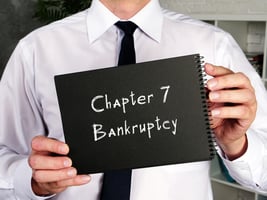Handling Secured Debts in a Chapter 7 Bankruptcy
When a person files a chapter 7 bankruptcy case, they often have secured debts. These types of debts are secured to certain property, known as “collateral,” which can be taken to satisfy the debt if the debt is not repaid by the borrower. Home mortgages and car loans are examples of secured debts as the lender retains a “lien” on the home or car (the collateral) and can foreclose on the home, or repossess the car, if the borrower defaults on their monthly payments on the debt.
The chapter 7 bankruptcy petition contains a form known as a “Statement of Intention.” In this form, the chapter 7 bankruptcy filer (aka the “debtor”) must state whether they want to keep or surrender all of their property that is secured by debt. If the debtor intends to surrender the property, they simply state so in the Statement of Intention. After the debtor files their bankruptcy case, they must honor their intent by cooperating with the lender to allow them take the property back. The lender can then repossess the property, by way of a foreclosure for homes, or repossession for cars and other personal property, but cannot ever again pursue the debt against the debtor (i.e. by bringing a lawsuit against them).
If the debtor wants to keep the property, they can choose to do so by stating that they intend to reaffirm the debt or redeem the property. A reaffirmation of a debt is essentially a promise by the debtor to pay off the debt in exchange for being able to keep the property. The Bankruptcy Code provides that the official way for a debtor to reaffirm a secured debt is for the debtor to sign a Reaffirmation Agreement, which legally binds them to continue making payments on the vehicle until the debt is paid off. The Reaffirmation Agreement, which is filed with the Bankruptcy Court, prevents the lender from taking back the property, so long as the debtor does not default on the repayment terms of the agreement. However, the downside to signing the Reaffirmation Agreement is that, should the debtor default on the agreement, the lender can repossess, or foreclose upon, the property, and the debtor still remains liable for the entire debt. Therefore, if the lender takes back the property, and sells it for less than the debt owed (aka a “deficiency balance”), they may pursue the remaining debt against the debtor, such as by bringing lawsuit against the debtor. Very often, the lender will allow the debtor to keep the property so long as they continue making payments on the debt to avoid the effort, cost and risk of repossessing the property, even though they have the legal right to do so, if the debtor doesn’t sign a reaffirmation agreement. For this reason, it is often more beneficial for the debtor to simply continue making payments on the debt and not sign a reaffirmation agreement. It is wise to discuss the risks versus benefits of signing a reaffirmation agreement with an experienced bankruptcy attorney before filing a chapter 7 bankruptcy case.
The other option that a debtor has to keep property that serves as collateral for a secured debt is to redeem the property. To redeem property, the debtor simply pays the full value of the property and essentially buys the property from the lender free and clear of any liens. This is a great option if the property is worth less than the amount of debt owed and the debtor can come up with a lump sum payment, as the lender will usually not allow a payment plan if the debtor chooses to redeem the property. Also, in order to redeem the property the debtor and lender must either agree on the valuation of the property, or the Bankruptcy Court will have to have a hearing in which it determines the appropriate value. One the valuation is set by the Court the debtor must pay this amount if they wish to successfully redeem the property.
So, in summation, in a chapter 7 bankruptcy, the debtor must fill out a Statement of Intent with their bankruptcy petition, in which they state whether they intend to keep the property by reaffirming the debt or redeeming the property, or whether they intend to surrender the property back to the creditor. Notably, the debtor must honor and fulfil whatever they state they will do in the Statement of Intent no later 30 days after their Creditor’s Meeting, which usually takes places about a month after the case is filed (so typically the debtor has about two months to follow through with what they said they intend to do in their Statement of Intent).
CALL NOW FOR A FREE STRATEGY SESSION FROM A MN BANKRUPTCY LAWYER AT LIFEBACK LAW FIRM
Due to the fact that there are a lot of things to consider when making the important decision of how to handle debts secured by one’s property in a bankruptcy, a person thinking about filing a chapter 7 bankruptcy case with secured debts should first discuss their situation with an experienced bankruptcy attorney. See us at LifeBackLaw.com!







